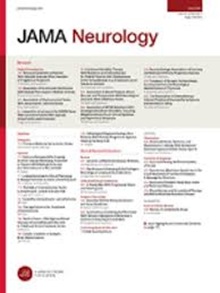Interstitial Thermal Therapy in Mesial Temporal Lobe Epilepsy.
IF 21.3
1区 医学
Q1 CLINICAL NEUROLOGY
引用次数: 0
Abstract
Importance Laser interstitial thermal therapy (LITT) is a surgical tool used to ablate epileptic foci and brain tumors. Understanding clinical and procedural outcomes of LITT for mesial temporal lobe epilepsy (MTLE) is relevant to clinicians and patients. Objective To describe seizure outcomes, procedural outcomes, and safety data of MTLE LITT. Design, Setting, and Participants Laser Ablation of Abnormal Neurological Tissue Using Robotic NeuroBlate System (LAANTERN) is a prospective multicenter registry with up to 5 years of follow-up lasting from October 2015 to March 2023 at LAANTERN epilepsy sites, which are all level IV National Association of Epilepsy Centers in the US. Adult and pediatric LAANTERN enrollees undergoing LITT for drug-resistant MTLE with at least 6 months of follow-up were included. Those with epilepsy related to a malignant lesion were excluded. Intervention LITT for drug-resistant MTLE. Main Outcomes and Measures Demographic, epilepsy, and seizure characteristics; procedural data; postsurgical seizure outcomes; safety data; and quality of life (QOL) scores were prospectively collected. Results Fifteen centers enrolled 145 patients (73 [50.3%] female) with MTLE undergoing LITT, with 77 reaching 2-year follow-up. The mean (SD) age was 39.2 (15.4) years at time of LITT with 14 of 145 in the pediatric range (younger than 22 years). The 2 most common etiologies were mesial temporal sclerosis (n = 74) and unknown etiology or magnetic resonance imaging normal (n = 31). Mean (SD) ablation volume was 28.2 (29.8) mL. Mean (SD) surgery duration was 4.3 (2.1) hours, and mean (SD) blood loss was 22 (17.6) mL. Median (IQR) length of stay was 1 (1-3) day, and 33 patients (23%) had no intensive care unit stay postprocedure. Median (IQR) intensive care unit time was 22 (19.2-28.8) hours. Mean (SD) discharge head pain score was 2.1 (2.6) on a 0-10 scale. Most patients (n = 140 [96.6%]) were discharged home. Two-year seizure outcomes were 45 of 77 (58.4%) and 44 of 77 (57.2%) for Engel 1 and International League Against Epilepsy 1/2, respectively. No clinical characteristics were associated with seizure outcome. Adverse events were seen in 24 patients (16.5%), most being mild and transient. Pediatric seizure outcomes were similar to adult outcomes. One-third of patients stopped or decreased their antiseizure medicines. Improvements in QOL scores were seen at almost all time points assessed. Conclusions In the largest prospective multicenter MTLE LITT cohort, LITT was found to be well tolerated with clinically meaningful seizure outcomes and QOL improvements. These findings indicate that LITT may be considered as a treatment option for drug-resistant MTLE.间质热疗法治疗内侧颞叶癫痫。
激光间质热疗法(LITT)是一种用于消融癫痫灶和脑肿瘤的手术工具。了解LITT治疗内侧颞叶癫痫(MTLE)的临床和程序结果对临床医生和患者都有重要意义。目的描述MTLE LITT的癫痫发作结局、手术结局和安全性数据。设计、设置和参与者使用机器人神经叶片系统(LAANTERN)激光消融异常神经组织是一项前瞻性多中心注册研究,从2015年10月至2023年3月在LAANTERN癫痫站点进行长达5年的随访,这些癫痫站点都是美国国家癫痫协会IV级中心。成人和儿童LAANTERN入组者接受LITT治疗耐药MTLE,随访至少6个月。那些与恶性病变相关的癫痫被排除在外。对耐药MTLE的干预。人口统计学、癫痫和发作特征;程序数据;术后癫痫发作结果;安全数据;并前瞻性收集生活质量(QOL)评分。结果15个中心共纳入145例MTLE患者(73例[50.3%]女性),其中77例随访2年。LITT时的平均(SD)年龄为39.2(15.4)岁,145例中有14例为儿科(小于22岁)。2种最常见的病因是内侧颞叶硬化(n = 74)和病因不明或磁共振成像正常(n = 31)。平均(SD)消融量为28.2 (29.8)mL,平均(SD)手术持续时间为4.3(2.1)小时,平均(SD)失血量为22 (17.6)mL。中位(IQR)住院时间为1(1-3)天,33例(23%)患者术后无重症监护。重症监护病房时间中位数为22(19.2 ~ 28.8)小时。平均(SD)出院头疼痛评分为2.1(2.6),评分范围为0-10。大多数患者(n = 140[96.6%])出院回家。Engel 1组和International League Against Epilepsy 1/2组的两年癫痫发作率分别为45 / 77(58.4%)和44 / 77(57.2%)。没有临床特征与癫痫发作结果相关。24例(16.5%)患者出现不良事件,大多数是轻微和短暂的。儿童癫痫发作的结果与成人相似。三分之一的患者停止或减少抗癫痫药物的使用。在几乎所有评估的时间点上,生活质量得分都有所改善。结论在最大的前瞻性多中心MTLE LITT队列中,LITT耐受性良好,具有临床意义的癫痫发作结局和生活质量改善。这些发现表明,LITT可能被认为是耐药MTLE的一种治疗选择。
本文章由计算机程序翻译,如有差异,请以英文原文为准。
求助全文
约1分钟内获得全文
求助全文
来源期刊

JAMA neurology
CLINICAL NEUROLOGY-
CiteScore
41.90
自引率
1.70%
发文量
250
期刊介绍:
JAMA Neurology is an international peer-reviewed journal for physicians caring for people with neurologic disorders and those interested in the structure and function of the normal and diseased nervous system. The Archives of Neurology & Psychiatry began publication in 1919 and, in 1959, became 2 separate journals: Archives of Neurology and Archives of General Psychiatry. In 2013, their names changed to JAMA Neurology and JAMA Psychiatry, respectively. JAMA Neurology is a member of the JAMA Network, a consortium of peer-reviewed, general medical and specialty publications.
 求助内容:
求助内容: 应助结果提醒方式:
应助结果提醒方式:


